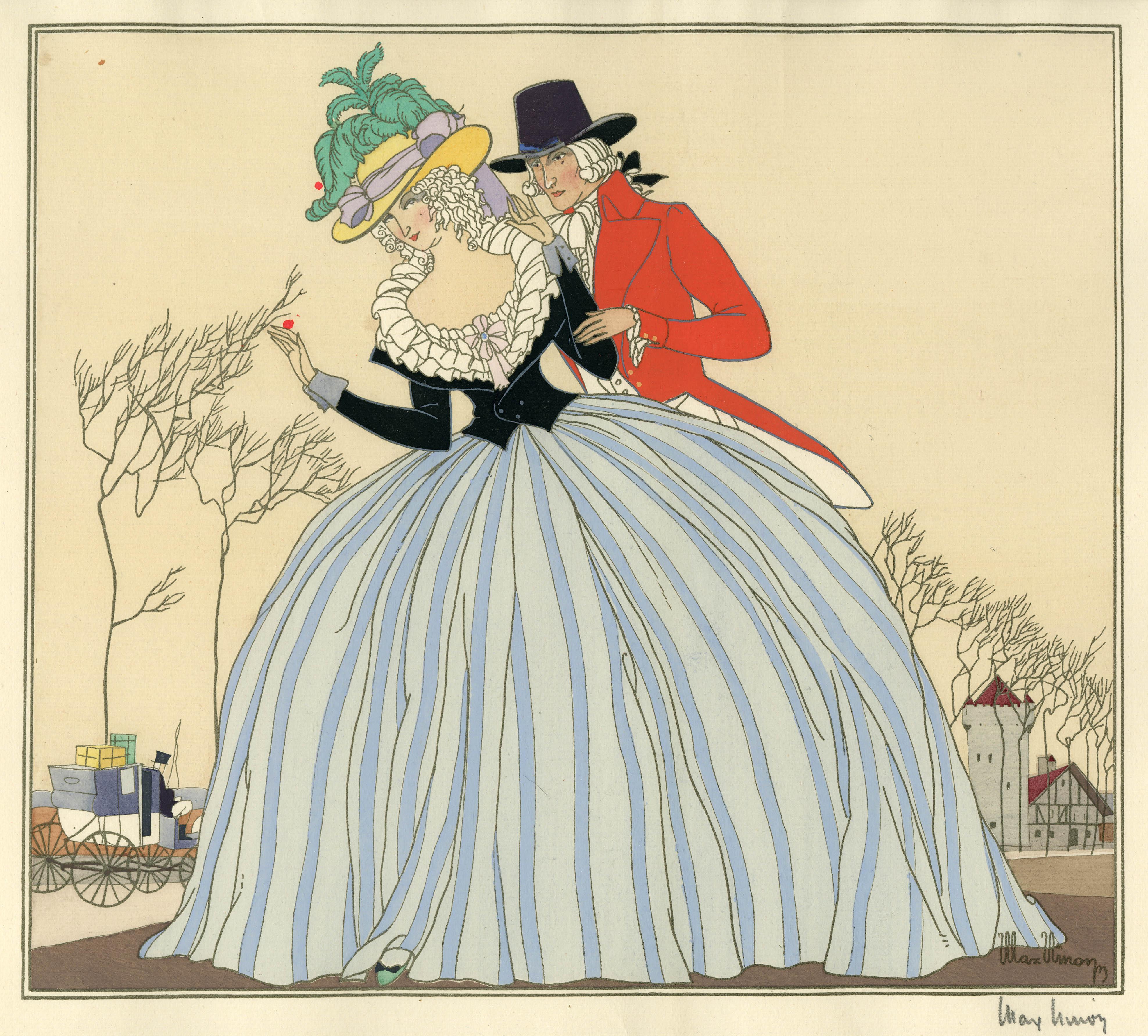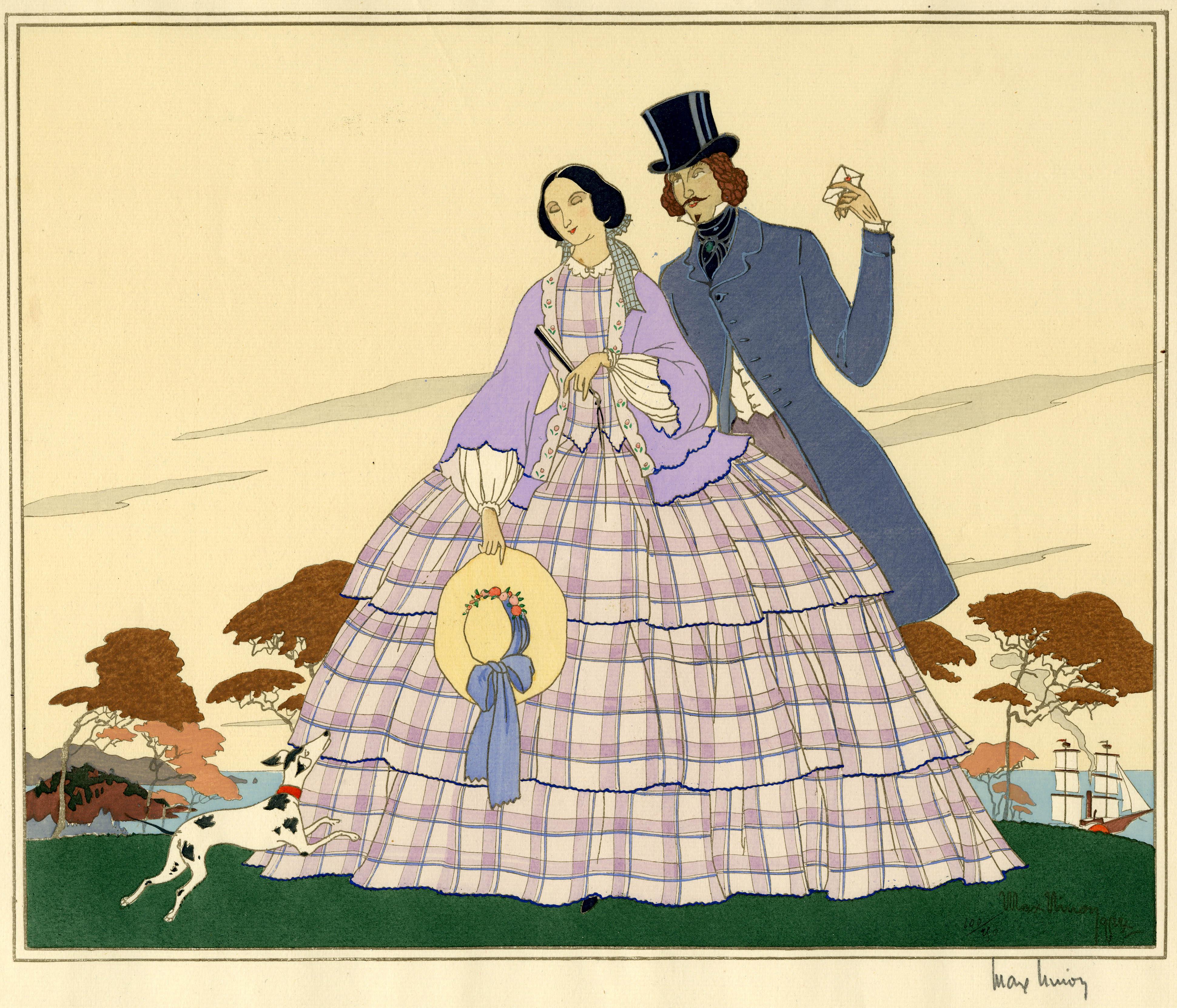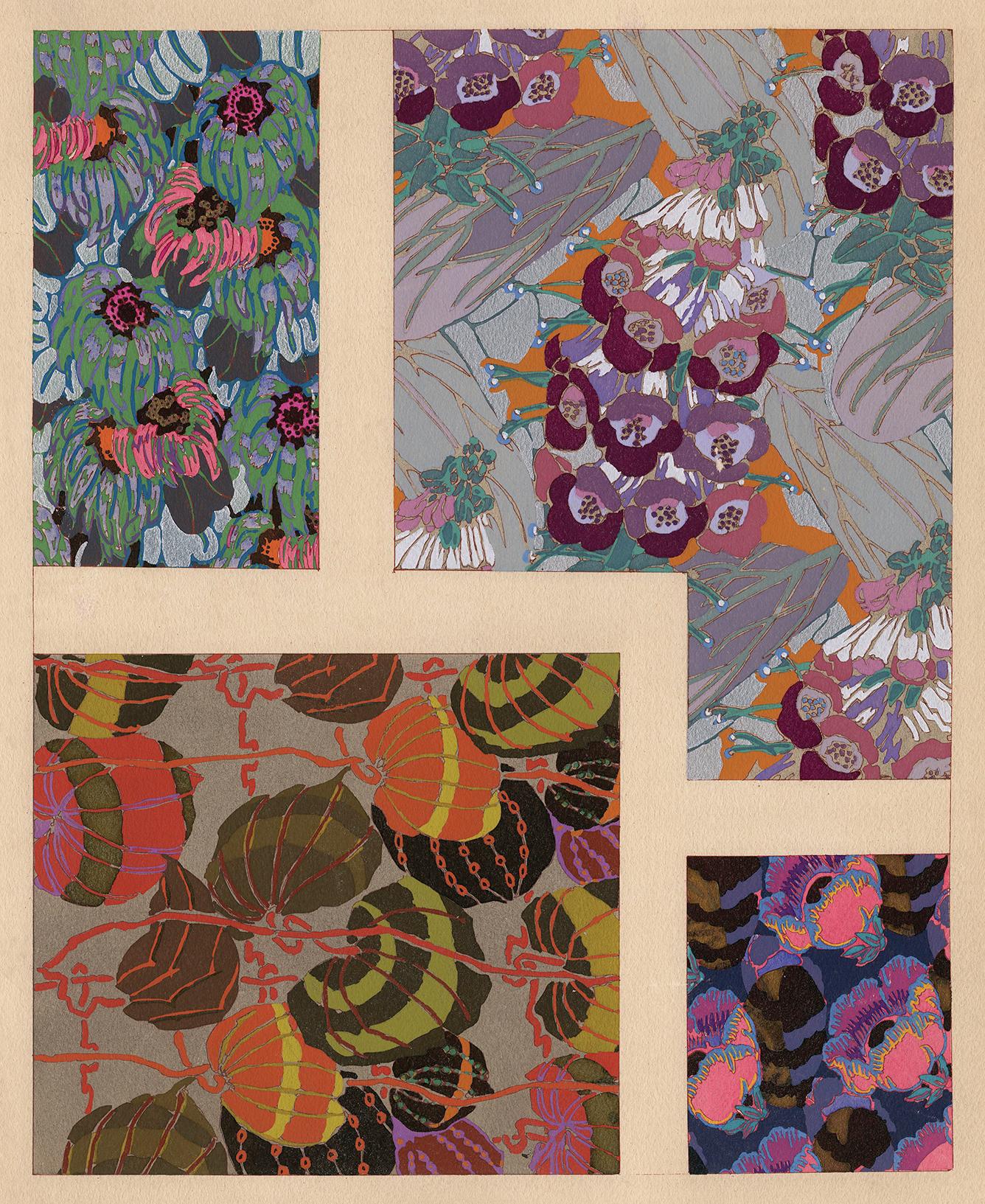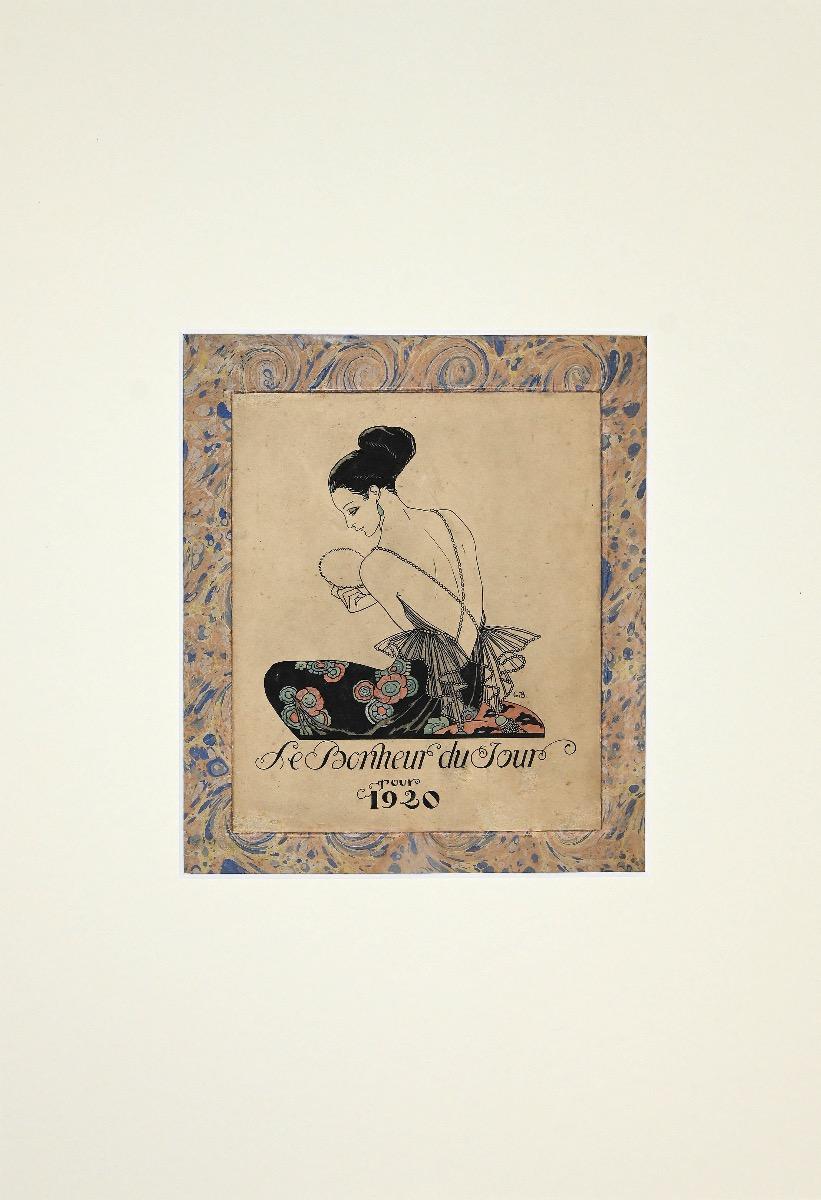Items Similar to “Sylvia”
Want more images or videos?
Request additional images or videos from the seller
1 of 7
Germaine-Paule Jaumard“Sylvia”1921
1921
About the Item
Original fashion illustration for Tres Parisien, December, 1921
Moroccan Crepe Dress by Germaine-Paule Joumard, Fashion Art Deco Pochoir on Chinese Paper. Artwork size is 7.5 by 5 inches. Signed Germaine Paule lower right. Illustration size is 10 by 6.5 inches. Under glass. Condition is very good. Toning of paper consistent with its age. Overall framed measurements are 18 by 14 inches. Provenance: A Sarasota, Florida gentleman.
Germaine-Paule Joumard was a well known French fashion illustrator in the Art Deco period in Paris.
Simply stated, pochoir is the French word for stencil. In the 1920’s and 30’s Art Deco era, the color application process of the stencil was rejuvenated by the French, bringing color illustration processes for books and prints to new glorious heights. This interest in exploring the stencil process came in reaction to the proliferation of machine printing and the poor quality of color reproductions in publishing. With pochoir printing, the hand application of layers of pigment created dazzling effects that the camera or printing press could never replicate. Earlier stencil works, typically used for decorative surface ornament were quite primitive, with applied color areas outlined by the supporting cutout framework. New experimental techniques in pochoir refined the process using multiple layers of color applications for a single print. Pochoir printing was also easily combined with images made by lithography, woodcut, wood engraving, line drawings, or etchings, thus turning a decorative technique into fine art.
Many artists (including Picasso, Miró, and Matisse) used studios specializing in this technique to create limited edition reproductions of a work of art. Using hand-cut stencils and stippled brush and sponge application, each pochoir is considered an original work of art. In pochoir prints, the edition number refers to the number of unique prints made before the fragile stencil is destroyed during the wear and tear of the printing process.
- Creator:Germaine-Paule Jaumard (French)
- Creation Year:1921
- Dimensions:Height: 7.5 in (19.05 cm)Width: 5 in (12.7 cm)Depth: 1.25 in (3.18 cm)
- Medium:
- Movement & Style:
- Period:
- Condition:Very good condition. Artwork is glued down top and bottom onto printed illustration.
- Gallery Location:Southampton, NY
- Reference Number:1stDibs: LU14113625132
About the Seller
5.0
Platinum Seller
These expertly vetted sellers are 1stDibs' most experienced sellers and are rated highest by our customers.
Established in 1977
1stDibs seller since 2013
468 sales on 1stDibs
Typical response time: 1 hour
- ShippingRetrieving quote...Ships From: Sarasota, FL
- Return PolicyA return for this item may be initiated within 7 days of delivery.
More From This SellerView All
- “Modele et Sculpeur avec sa Sculpure”By (after) Pablo PicassoLocated in Southampton, NYDescription: Pablo Picasso created the Suite Vollard between 1930 and 1939 in honor of his friend and art dealer, Ambroise Vollard. The suite is comprised of 100 etchings, illustrat...Category
1990s Modern Figurative Prints
MaterialsLithograph, Archival Paper
- “Scene in Union Square, New York on a March DayBy Winslow HomerLocated in Southampton, NYOriginal wood engraving on paper. Taken from Harper’s Weekly, April 7, 1860. Signed “Homer” in the plate. Condition is good. Slight staining lower left. Very slight tear to the l...Category
1860s Academic Figurative Prints
MaterialsArchival Paper, Engraving
- “Chess Players”Located in Southampton, NYARTIST Hey, Paul, 1867-1952, artist TITLE Chess players OTHER TITLE(S) Die Schachspieler PHYSICAL DESCRIPTION 1 print : etching ; sheet size 11 1/2" x 15" (30 x 39 cm.) Date: 1898 SUMMARY Three men are sitting around a chess board, two are playing and one is observing. The men are all late middle aged to old aged. The print has some fine details, and cross hatching is used extensively. On the table, besides the the chess set, are two coffee cups and a glass of water. Lower left in margin in pencil “original etching” in German. Lower right margin in pencil “chess players” written in German. No visible signature. The same etching by Paul Hey...Category
1890s Academic Figurative Prints
MaterialsArchival Paper, Etching
- “Adam and Eve”By Jack LevineLocated in Southampton, NYOriginal etching on archival paper by Jack Levine. Condition is very good; strong impression. Done in 1963. The etching is housed in a contemporary matte black frame. Under glass. Overall framed measurements are 24.5 by 17.25 inches. Provenance: A Sarasota, Florida estate. Publication Printed by Emiliano Sorini; published by Associated American Artists Full sheet; not trimmed. 22 by 15 inches Edition 74/100 in pencil lower left margin. Pencil signed by artist lower right margin Jack Levine American, 1915–2010 A painter and printmaker best known for political and social commentaries, Jack Levine drew inspiration from satirical German expressionist artists, such as George Grosz and Oskar Kokoscha, and took stylistic cues from the paintings of Titian, Diego Velázquez, and Francisco de Goya. Rejecting the formal qualities and ideologies of contemporary art movements, Levine caricatured 20th-century issues—inequality, big business...Category
1960s Post-Modern Figurative Prints
MaterialsEtching, Archival Paper
- “Untitled”By Jean DufyLocated in Southampton, NYOriginal lithographic print done as a gravure using black ink attributed to the hand of the well known French artist, Jean Dufy. Signed in the plate “Dufy” lower right. Circa 1960. Condition is very good. “Pierre Hautot...Category
1960s Post-Modern Figurative Prints
MaterialsLithograph, Archival Paper
- “Venice”By Marc ChagallLocated in Southampton, NYDescription: People have collected autographs of notables for hundreds of years. The desire to have a personal memento from a famous and or important artist drives the collecting field. The top rung of the ladder, in terms of popularity, is a relatively small group of artists called ‘icons’. These are people who’s names and images stay with us, appearing with regularity in our culture. The 20th Century Masters such as Chagall, Picasso, Matisse, Miro, Dali and more recently, Warhol fit this description. The renowned French printer, Fernand Mourlot, printed many of the original posters for the most important artists of the day. In 1959 the studio printed the series Affiches Originales for collectors. They are reduced lithographic versions of the original posters created by the contemporary masters, Picasso, Chagall, Braque, Matisse, Miro, Leger, and Dufy. This announcement was for an Easter exhibition in the city of Vence. This very rare and desirable 1959 Mourlot poster, of which only 1500 were printed and only a handful known to have been signed, has been signed in pencil by the artist, Marc Chagall. The original larger poster...Category
1950s Modern Figurative Prints
MaterialsLithograph, Archival Paper
You May Also Like
- "No More Heroes" – Acrylic Screen Print on PaperBy Plastic JesusLocated in West Hollywood, CAPlastic Jesus is a Los Angeles based street artist that specializes in bold stencil and installation work, inspired by world news events, society, the urban environment, culture and ...Category
2010s Pop Art Figurative Prints
MaterialsStencil, Archival Paper, Acrylic
- CoquetteBy Victor Max NinonLocated in Fairlawn, OHCoquette Pochoir (silk screen) printed in colors, c. 1923-1925 Signed by the artist in pencil lower right; numbered in ink on the image, (see photo) Edition: 250 (100/250) in pencil in image (see photo) Image size: 10-1/2 x 12-3/4" The artist won a gold medal in Paris in 1925 for his porchoirs Victor Max Ninon (Vittorio Accornero de Testa, Italian, 1896-1982) Biography Vittorio Accornero de Testa was born in Casale Monferrato in 1896. He completed his first studies at the "Leardi" institute, but was forced to interrupt them due to the war events of the First World War . At 19 he was second lieutenant of the Alpine troops and in 1916 he took one of the first pilot's licenses. During the war he knows the bitterness of shooting down in air combat (for which he is decorated), but also the good fortune to stay alive, albeit with a disability. His art blossomed in the postwar period, first signing his works simply Ninon and then, probably at the suggestion of a French publisher, under the pseudonym of "Victor Max Ninon" (Victor and Max indicate strength and masculinity, Ninon boyhood) .In 1919 and 1924 he made illustrations for theGiornalino della Domenica , also together with his first wife Edina Altara , for Ardita and La Lettura . In 1923 he won the cover competition organized by the magazine El Hogar of Buenos Aires and in 1925 with his pochoirs he imposed himself in Paris at the international exhibition of modern decorative and industrial arts , obtaining a gold medal. In the same year he made two covers for the US magazine The Smart Set . In the 1920s he made numerous series of art deco style postcards for the Milanese publishing house Degami . On June 4, 1929, aGenoa embarks on the Conte Grande together with his wife Edina Altara , for New York . The two stayed in the American metropolis for a few months: in this period Accornero worked on the creation of theatrical sets and created some covers for Country Life magazine . Accornero gets awards and prizes, but the great economic crisis of the time and the nostalgia for Italy convince the two to return to their homeland, where they resume their activity as illustrators. In 1934 Accornero moved to Milan, separated amicably from his wife and continued to dedicate himself to the illustration of children's books, abandoning the pseudonym Victor Max Ninon. It illustrates about 60 books, from the fables of Andersen , Perrault and Grimm , to the tales of Poe , as well as the famous Pinocchio and Cuore published by Mondadori, Mursia, Hoepli, Martello. Several books illustrated by Accornero have been published in French, Spanish, German and English. In addition to the periodicals already mentioned, he collaborates on the first edition of the Encyclopedia of Boys , Mondadori, and with the Italian magazines Lidel , Il Secolo XX, The Italian Illustration , Fantasies of Italy , The Woman , Cordelia , For You Lady , Grace , Metropolis , La Domenica del Corriere , The Corriere dei Piccoli . In 1936 enters the world of cinema, creating sets and costumes for Wedding Vagabonde of Guido Brignone and The White Squadron of Augustus Genina . From 1935 to 1950 he also devoted himself to the theater, taking care of sets and costumes for numerous operettas, ballets and performances at the Scala in Milan and for the Milanese theaters Manzoni, Lirico and Olympia. Stages Marcello di Giordano, Nina pazza d'amore by Paisiello, I cantori di Nurimberga by Wagner, La Bohème by Puccini and other works. For this activity he is also cited in the Theater encyclopedia. In the 1940s and 1950s he wrote and illustrated six books for children for Mondadori: Tomaso (1944), Giacomino (1949), Tomaso Cacciatore (1950), Zio Stefano (1950), In Campagna che delizia! (1953), Tomaso, dear Tomaso (1955). His illustrations of Perrault's Tales published in those years by Hoepli are famous. His art in the fifties evolves towards hyperrealism . There are many personal exhibitions in Italy and abroad, including those at the Gallerie Gussoni (1959) and Bolzani (1963 and 1966) in Milan and Walcheturm (1962) in Zurich. Eminent critics praise his work, from Orio Vergani to Enrico Piceni, from Reto Roedel to De Chirico himself. On the Domenica del Corriere , the journalist, writer and painter Dino Buzzati...Category
1920s Art Deco Figurative Prints
MaterialsStencil
- Robe GriseBy Victor Max NinonLocated in Fairlawn, OHRobe Grise Pochoir (silk screen) printed in colors, 1923 Signed by the artist in pencil lower right (see photo) The artist won a gold medal in Paris in 1925 for his pochoirs Condition: Two spots in the upper left corner associated with the printing. Victor Max Ninon (Vittorio Accornero de Testa, Italian, 1896-1982) Biography Vittorio Accornero de Testa was born in Casale Monferrato in 1896. He completed his first studies at the "Leardi" institute, but was forced to interrupt them due to the war events of the First World War . At 19 he was second lieutenant of the Alpine troops and in 1916 he took one of the first pilot's licenses. During the war he knows the bitterness of shooting down in air combat (for which he is decorated), but also the good fortune to stay alive, albeit with a disability. His art blossomed in the postwar period, first signing his works simply Ninon and then, probably at the suggestion of a French publisher, under the pseudonym of "Victor Max Ninon" (Victor and Max indicate strength and masculinity, Ninon boyhood) .In 1919 and 1924 he made illustrations for theGiornalino della Domenica , also together with his first wife Edina Altara , for Ardita and La Lettura . In 1923 he won the cover competition organized by the magazine El Hogar of Buenos Aires and in 1925 with his pochoirs he imposed himself in Paris at the international exhibition of modern decorative and industrial arts , obtaining a gold medal. In the same year he made two covers for the US magazine The Smart Set . In the 1920s he made numerous series of art deco style postcards for the Milanese publishing house Degami . On June 4, 1929, aGenoa embarks on the Conte Grande together with his wife Edina Altara , for New York . The two stayed in the American metropolis for a few months: in this period Accornero worked on the creation of theatrical sets and created some covers for Country Life magazine . Accornero gets awards and prizes, but the great economic crisis of the time and the nostalgia for Italy convince the two to return to their homeland, where they resume their activity as illustrators. In 1934 Accornero moved to Milan, separated amicably from his wife and continued to dedicate himself to the illustration of children's books, abandoning the pseudonym Victor Max Ninon. It illustrates about 60 books, from the fables of Andersen , Perrault and Grimm , to the tales of Poe , as well as the famous Pinocchio and Cuore published by Mondadori, Mursia, Hoepli, Martello. Several books illustrated by Accornero have been published in French, Spanish, German and English. In addition to the periodicals already mentioned, he collaborates on the first edition of the Encyclopedia of Boys , Mondadori, and with the Italian magazines Lidel , Il Secolo XX, The Italian Illustration , Fantasies of Italy , The Woman , Cordelia , For You Lady , Grace , Metropolis , La Domenica del Corriere , The Corriere dei Piccoli . In 1936 enters the world of cinema, creating sets and costumes for Wedding Vagabonde of Guido Brignone and The White Squadron of Augustus Genina . From 1935 to 1950 he also devoted himself to the theater, taking care of sets and costumes for numerous operettas, ballets and performances at the Scala in Milan and for the Milanese theaters Manzoni, Lirico and Olympia. Stages Marcello di Giordano, Nina pazza d'amore by Paisiello, I cantori di Nurimberga by Wagner, La Bohème by Puccini and other works. For this activity he is also cited in the Theater encyclopedia. In the 1940s and 1950s he wrote and illustrated six books for children for Mondadori: Tomaso (1944), Giacomino (1949), Tomaso Cacciatore (1950), Zio Stefano (1950), In Campagna che delizia! (1953), Tomaso, dear Tomaso (1955). His illustrations of Perrault's Tales published in those years by Hoepli are famous. His art in the fifties evolves towards hyperrealism . There are many personal exhibitions in Italy and abroad, including those at the Gallerie Gussoni (1959) and Bolzani (1963 and 1966) in Milan and Walcheturm (1962) in Zurich. Eminent critics praise his work, from Orio Vergani to Enrico Piceni, from Reto Roedel to De Chirico himself. On the Domenica del Corriere , the journalist, writer and painter Dino...Category
1920s Art Deco Figurative Prints
MaterialsStencil
- 'Variations, 10' — 1920s French Art Deco PochoirBy Edouard BenedictusLocated in Myrtle Beach, SCEdouard Benedictus, 'Variations, plate 10' from the portfolio 'Variations Quatre-Vingt-Six Motifs Décoratifs en Vingt Planches', color pochoir, edition not stated, 1923. Signed in the matrix, in the left bottom margin. A superb, painterly impression, with fresh, vivid colors and metallic silver, on heavy, cream wove paper with margins (1 to 1 3/4 inches). A repaired tear in the center left margin, not affecting the image, in good condition. Archivally sleeved, unmatted. Image size 14 3/8 x 11 9/16 inches; sheet size 17 3/8 x 13 7/8 inches. The pochoir production is by Jean Saudé, the French printmaker known for his mastery of the technique and the author of the first how-to book on the pochoir process. Published by Éditions Albert Levy, Librairie Centrale des Beaux-Arts, Paris. Collections: Metropolitan Museum of Art, Minneapolis Institute of Art, New York Public Library, Victoria and Albert Museum. Additional works from this suite of vibrant Art Deco floral designs are available from Keith Sheridan LLC...Category
1920s Art Deco Figurative Prints
MaterialsStencil
- Frontispiece for Le Bonheur du Jour - Pochoir by G. Barbier - 1929By George BarbierLocated in Roma, ITLe Bonheur du Jour by George Barbie (Nantes, 1889 - Paris, 1932) is an artwork realized in 1929. Original colored pochoir on cardboard. Perfect conditions. Le Bonheur du Jour is...Category
1920s Art Deco Figurative Prints
MaterialsStencil
- Le Bonheur du Jour - Pochoir by George Barbier - 1929By George BarbierLocated in Roma, ITLe Bonheur du Jour by George Barbie (Nantes, 1889 - Paris, 1932) is an original artwork realized in 1929 cover of the homonymous suite of pochoir realized b...Category
1920s Art Deco Figurative Prints
MaterialsStencil
Recently Viewed
View AllMore Ways To Browse
The Who Drawing Poster
Lithographs Early 20 Century
Louis Vuitton Francis
Lithographs Irish Artists
Picasso Lithograph Face
Emile Bourgeois
Salvador Dali Pig
Avigdor Candle
Black Woman Unknown Artist
Indian Pop Art
Speak With An Assistant
Dali Painting Lithograph
Non Non Non Et Non
Veil Italian
Le Pays Des Miracles
Lichtenstein I Love Liberty
Mady De La Giraudiere
Medee Sarah Bernhardt





